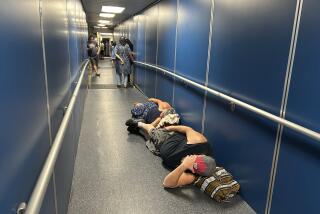Op-Ed: How phantom flushing wastes water, and how to fix it
- Share via
As California faces unprecedented, mandatory water restrictions, the big question is where, exactly, the cuts should come from. Experts and pundits alike most frequently mention agriculture, because of its disproportionate water usage. They also single out golf courses, cemeteries and other places with extensive landscaping. But what about the hundreds of thousands of automatic flush toilets across the state? No one seems to talk about them, but they’re significant water wasters, and two huge concentrations of them can be found in California’s largest airports: San Francisco International and Los Angeles International .
More than 110,000 people walk through SFO daily, and many inevitably use one of the airport’s restrooms. Simply entering a stall with an automated toilet will often trigger a “phantom flush.” Many have experienced this effect in their office restrooms and other public places. Sometimes just laying a paper cover on the seat, or an ill-timed fidget, can trigger an unintended flush. And while a single errant flush may not amount to much, multiply that happening several times a day. The Environmental Protection Agency estimates that there are 27 million automatic flush toilets in the United States.
According to the San Francisco Public Utilities Commission, SFO is the highest water consumer in the city, using more than 128 million gallons of water in the four-month period of February to May 2014, and an estimated 384 million gallons annually. (For comparison, the second-highest water user is the Housing Authority, at about 108 million gallons.) Even though SFO’s usage was down 6% from the previous year, the airport will have to do much more to meet Gov. Jerry Brown’s reduction mandates.
LAX’s water usage was significantly higher at 544 million gallons in 2013, although that was down 25% from 2011, according to a Los Angeles World Airport newsletter in February.
How much more water is used by automatic flush than manual flush toilets? In 2010, Maximum Performance Testing, an organization that tests toilets, published a study comparing the two in an office building in Tampa, Fla. The study first measured baseline water usage over several months with existing 1.6-gallon manual flush toilets. They then replaced the manual flush levers on all toilets with sensor-operated automatic flush mechanisms, and monitored water usage over the next few months.
The results were startling: Usage jumped 54%, from 807 gallons per day to 1,243 gallons per day. Because the volume per flush and the population of the building remained constant, the testing firm concluded that the increase was due to unnecessary phantom flushing.
An airport and an office building are obviously different. But we can extrapolate the data from the Florida study to SFO and LAX and get a pretty good picture. The study found that toilet flushing adds up to about 44% of the water used in restrooms. At SFO, that would amount to about 95 million gallons annually. Switching from automatic to manual flushing could thus result in 54% water savings annually, or more than 33 million gallons just in restrooms, and nearly 9% in water reduction airportwide.
At LAX, similar measures could result in a 47-million-gallon annual water savings. Together, these two airports could save more than 80 million gallons of water annually just by converting to manual-flush toilets. This amount of water savings would be enough to provide water to Riverside County residents for a month.
Switching from automatic to manual flushing at just airports offers tremendous potential water savings. If we switched automated flush valves back to manual across the entire state, it could mean billions of gallons saved each year. As a cheap alternative, businesses could cover the sensor on the toilet and ask patrons to push the manual override flush button.
Not surprisingly, manufacturers of sensor-operated flush mechanisms blame phantom flushing on improper installation and maintenance. In a February article in the Guardian newspaper, a representative from American Standard noted: “It’s usually building maintenance or plumbers installing them, and a lot of times there’s just a lack of knowledge about how the products work. Once installed properly, you should be good to go.”
This is an absurd argument, considering how often phantom flushing happens. If a product is improperly installed in most cases, it points to a broader design problem with the product.
Manufacturers tout increased hygiene as a selling point. But with our shrinking water supply, is the potential risk of germs from a toilet lever worth the millions of gallons of water wasted?
Marika Shioiri-Clark is a designer who specializes in public interest design.
Follow the Opinion section on Twitter @latimesopinion and Facebook
More to Read
A cure for the common opinion
Get thought-provoking perspectives with our weekly newsletter.
You may occasionally receive promotional content from the Los Angeles Times.









